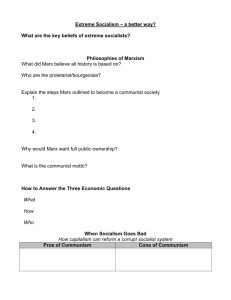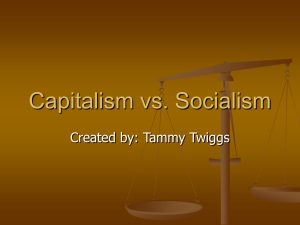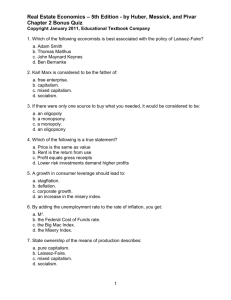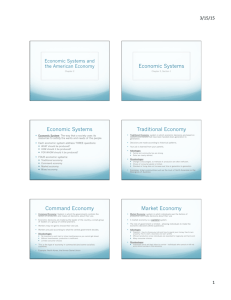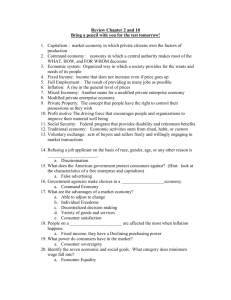CHAPTER 18
advertisement
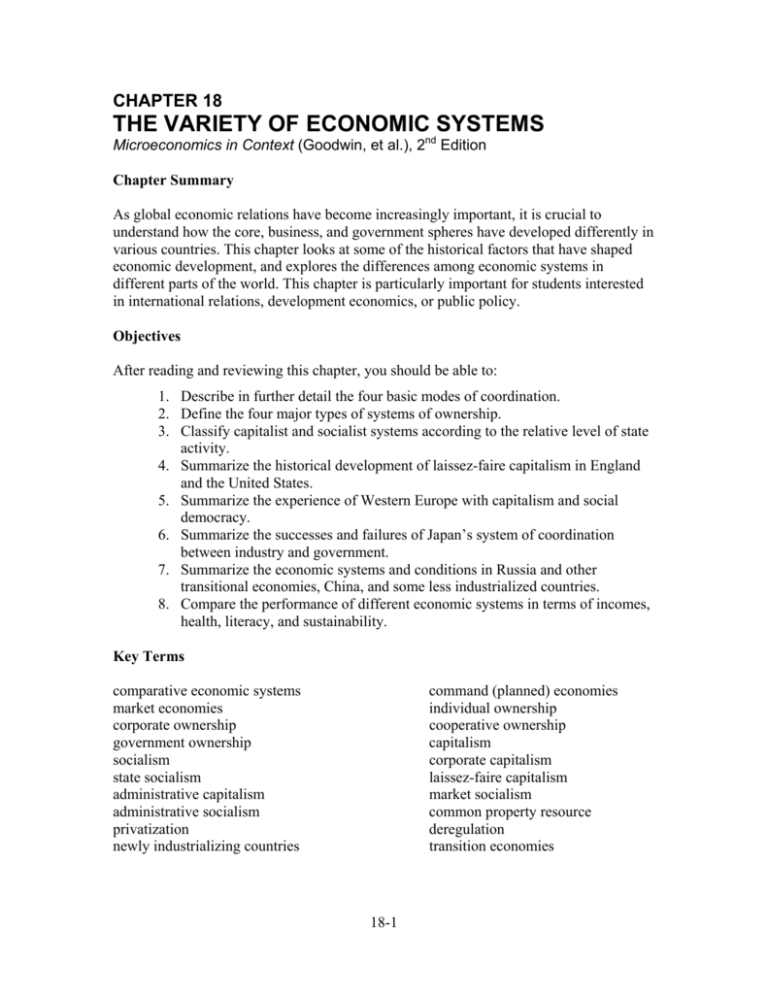
CHAPTER 18 THE VARIETY OF ECONOMIC SYSTEMS Microeconomics in Context (Goodwin, et al.), 2nd Edition Chapter Summary As global economic relations have become increasingly important, it is crucial to understand how the core, business, and government spheres have developed differently in various countries. This chapter looks at some of the historical factors that have shaped economic development, and explores the differences among economic systems in different parts of the world. This chapter is particularly important for students interested in international relations, development economics, or public policy. Objectives After reading and reviewing this chapter, you should be able to: 1. Describe in further detail the four basic modes of coordination. 2. Define the four major types of systems of ownership. 3. Classify capitalist and socialist systems according to the relative level of state activity. 4. Summarize the historical development of laissez-faire capitalism in England and the United States. 5. Summarize the experience of Western Europe with capitalism and social democracy. 6. Summarize the successes and failures of Japan’s system of coordination between industry and government. 7. Summarize the economic systems and conditions in Russia and other transitional economies, China, and some less industrialized countries. 8. Compare the performance of different economic systems in terms of incomes, health, literacy, and sustainability. Key Terms comparative economic systems market economies corporate ownership government ownership socialism state socialism administrative capitalism administrative socialism privatization newly industrializing countries command (planned) economies individual ownership cooperative ownership capitalism corporate capitalism laissez-faire capitalism market socialism common property resource deregulation transition economies 18-1 Active Review Questions Fill in the Blank 1. The four major modes of economic coordination are customary, consensual, administrative, and ________________. 2. A national economy characterized by administrative direction of economic via central bureaucracy is know as a ________________ economy (or a ________________ economy). 3. Economies in which exchange plays a major role are often referred to as ________________ economies. 4. The major systems of ownership are individual ownership, corporate ownership, ________________ ownership, and ________________ ownership. 5. In corporate ownership, assets are owned by ________________. 6. Resources that are owned collectively by a defined group (e.g. a group of farmers who collectively own grazing land) are known as ________________________________ resources. 7. South Korea, Taiwan, Singapore, and Hong Kong are all examples of ________________ ________________ countries. 8. The countries of the former Soviet Union and the countries of Eastern Europe and Asia that used to be under Soviet influence are referred to as _________________ economies. True or False 9. Market economies are almost always associated with democracy. 10. In command economies, people cannot have any private possessions. 11. Open access resources such as fish in the ocean are owned strictly through systems of government ownership. 12. Modernization in France and Germany involved considerably less government regulation than had characterized modernization in England and the United States. 13. The newly industrialized countries of East Asia are known for their success in using a laissez-faire approach to economic development. 18-2 14. The Japanese Ministry of International Trade and Industry (MITI) helps Japanese corporations to identify and move into promising areas of industry. Short Answer 15. Suppose that a friend tells you market economies only exist in democratic societies. What examples from history could you cite to contradict this view? _____________________________________________________________________ _____________________________________________________________________ _____________________________________________________________________ _____________________________________________________________________ 16. In the countries that began to modernize in the mid to late 19th century (such as France, Germany, and Sweden), the state played a relatively large role in development. Briefly describe the nature of this involvement. _____________________________________________________________________ _____________________________________________________________________ _____________________________________________________________________ _____________________________________________________________________ _____________________________________________________________________ _____________________________________________________________________ 17. In Sweden, anyone who has a child receives the same cash benefit from the government, regardless of income level. Describe some possible advantages and disadvantages to this approach. _____________________________________________________________________ _____________________________________________________________________ _____________________________________________________________________ _____________________________________________________________________ _____________________________________________________________________ _____________________________________________________________________ 18. What areas of production received the most emphasis in the economy of the Soviet Union? What areas tended to be neglected? _____________________________________________________________________ _____________________________________________________________________ _____________________________________________________________________ _____________________________________________________________________ _____________________________________________________________________ 19. Briefly describe the role of labor unions in the development of the post-World War II Japanese economy. _____________________________________________________________________ _____________________________________________________________________ _____________________________________________________________________ _____________________________________________________________________ 18-3 _____________________________________________________________________ _____________________________________________________________________ 20. Name three possible criteria that could be used to compare economies with one another. _____________________________________________________________________ _____________________________________________________________________ _____________________________________________________________________ Self Test 1. A system in which a great deal of the ownership of productive assets is through corporations, which in turn are owned by private shareholders, is known as a. b. c. d. e. democracy democratic capitalism the corporate society corporate capitalism state socialism 2. Which of the following countries has an economy characterized by administrative capitalism? a. b. c. d. e. Japan China Vietnam USA North Korea 3. Which of the following countries has an economy characterized by market socialism? a. b. c. d. e. Japan China France Sweden All of the above 4. Under laissez-faire capitalism, a. b. c. d. There is substantial state activity alongside market-organized activity. The role of the state is supposed to be relatively small. All ownership is through corporations. There is a continuous spectrum from the completely unregulated to the heavily administrative form of capitalism. e. Both b and c are true. 18-4 5. Which of the following statements best describes the difference between market socialism and administrative socialism? a. In market socialism, state ownership predominates but much activity is organized by exchange; in administrative socialism, activity is primarily organized by public administration. b. In market socialism, activity is primarily organized by public administration; in administrative socialism, state ownership predominates but much activity is organized by exchange. c. In market socialism, there is little state ownership; in administrative socialism, there is much state ownership. d. In market socialism, there is political freedom, whereas administrative socialism requires political repression. e. Both b and d are true. 6. Which of the following statements concerning the Anglo-American experience is false? a. England had a highly market-oriented economy by 1700. b. England enjoyed more than a century of uniquely favorable conditions for economic development. c. At the time of the American Revolution, the American colonies had about the same average standard of living as England. d. Industrialization led to immediate improvements in the living standards of the poor. e. Privatization and deregulation programs were undertaken in the 1970s. 7. In which of the following countries did the government play a relatively large role in regulating and guiding economic development? a. b. c. d. e. The United States The United Kingdom Germany France Both c and d are true. 8. In which of the following is an example of a service provided free or at a very low cost by the government in Sweden? a. b. c. d. e. child care health care higher education primary education all of the above 18-5 9. Which of the following is not considered a “newly industrializing country” (NIC)? a. b. c. d. e. South Korea Taiwan Japan Singapore Hong Kong 10. The economic performance of a country depends on its a. b. c. d. e. mode of economic coordination. natural resources. climate history all of the above 11. The mode of economic organization in which people come to explicitly negotiated agreements about production is known as a. b. c. d. e. administrative corporate governmental consensual customary 12. What is the defining characteristic of socialism? a. b. c. d. e. Democratic decision-making. Public ownership of productive assets. A repressive government. Cooperative decision-making. Proxy voting by all shareholders. 13. Which of the following terms best describes the economic system of Cuba? a. b. c. d. e. administrative capitalism laissez-faire socialism administrative socialism market socialism socialist capitalism 18-6 14. Which of the following statements about Japanese economic development is true? a. The government adopted a laissez-faire approach after World War II. b. Large and small businesses in Japan provide equally good benefits. c. The concept of life-long employment was proposed by the American postWar occupiers of Japan. d. The presence of strong unions had a major effect on Japanese post-war development. e. Military production has continued to be a major driver of economic growth in Japan. 15. Russia can be described as a(n) a. b. c. d. e. Transition economy. Administrative capitalist economy. Newly industrializing country (NIC). Corporate governance economy. None of the above. 16. Which of the following statements is false? a. The United States leads the world in per capita industrial CO2 emissions. b. China is a close second to the United States total CO2 emissions. c. The United States has a relatively high rate of deaths in early childhood compared with most high income countries. d. Vietnam has directed substantial resources to reducing child mortality compared with many low income counties. e. All of the above are true. 17. About what percentage of the world’s population lives in countries classified as “high-income”? a. b. c. d. e. 1% 4% 15% 55% 43% 18. Which of the following countries has the largest percentage of the world’s population? a. b. c. d. e. United States United Kingdom China India Russia 18-7 19. Which of the following statements is true? a. Clothing manufacture and electronics assembly have largely disappeared from the richest countries. b. A substantial governmental role in the economy nearly always produces successful economic development. c. India began its process of industrialization from an advantageous position, compared to that of the United Kingdom and the United States when they began to industrialize. d. Chinese economic development after 1978 was characterized by administrative socialism. e. Hong Kong, Taiwan, and Singapore are all considered “transition economies.” 20. A mode of economic organization that uses traditions and habits to answer the basic economic questions is called a. b. c. d. e. exchange. customary. consensual. capitalism. administration. Answers to Active Review Questions 1. exchange 2. command; planned 3. market 4. cooperative; state 5. shareholders 6. common-property 7. newly industrializing 8. transition 9. False. Market systems are compatible with widely varying political systems. 10. False. 11. False. Fish in the ocean do not come under any single country’s jurisdiction, and thus none of the four ownership categories described in the text can be applied precisely. 12. False. 13. False. 14. True. 15. The textbook points out a number of examples of market systems that have coexisted with repressive dictatorships: Spain in the 1950s and 1960s, Chile in the 18-8 1970s and 1980s, Indonesia from 1967 to 1998, and South Korea for most of the years since World War II. 16. In these countries, government took an active role in development both by adopting social policies to protect the most vulnerable members of society and by promoting industrial growth. 17. Advantages include low administrative costs, broad popular support for the program, and the elimination of any need for the government to collect details on industrial citizens’ financial circumstances. Disadvantages include high costs. 18. Heavy industry and military production were emphasized, while consumer goods and agriculture tended to be neglected. 19. Rapid unionization of the work force was allowed after Japan’s surrender in 1945. By 1948, more than half of all Japanese employees belonged to unions. These labor unions had important effects on the development of today’s Japanese economic system; for example, workers in large enterprises are guaranteed lifetime employment. 20. Some possible criteria include GDP, health and literacy, or sustainability. Answers to Self Test Questions 1. d 2. a 3. b 4. b 5. a 6. d 7. e 8. e 9. c 10. e 11. d 12. b 13. c 14. d 15. a 16. b 17. c 18. c 19. a 20. b 18-9



